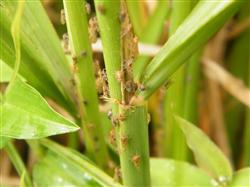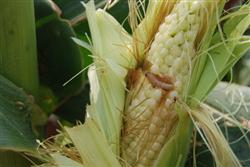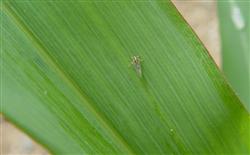How to control brown planthopper?

How to control brown planthopper? Please introduce the method to control brown planthopper, according to the occurrence and harm characteristics of brown planthopper, appropriate use of drugs, and according to the occurrence of brown planthopper in the field to select appropriate insecticides. The occurrence and damage characteristics of brown planthopper brown planthopper is a migratory pest, which can not survive the winter in the north of 25 °north latitude, and the insect source migrates back and forth from north to south generation by generation, region by region every year. In the Yangtze River basin and its northern areas, brown planthopper generally migrates after mid-late July, and usually forms a migration peak when typhoons and other south-to-north air currents pass through. The number of adults moving in each time is generally not large enough to cause great harm to rice in the field immediately. Usually after breeding in the field for a generation or two, the number of adults will increase to the extent that it can cause harm to rice. The adult brown planthopper has a long life span, a long spawning period and a large number of eggs. The life span of female adults of brown planthopper was 15-25 days at 26-28 ℃ (30 days at 17-20 ℃). The fecundity of female adults is strong, with 150 eggs per head, and more than 700 eggs (especially short-winged adults), the peak spawning period lasts 10-15 days, and the peak spawning period usually lasts 6-10 days. The time required for brown planthopper eggs to complete embryonic development was closely related to the air temperature. The egg period was 26.7,15.2, 8.2,7.9 and 8.5 days at 15 ℃, 20 ℃, 25 ℃, 28 ℃ and 29 ℃, respectively. The egg period was the shortest at about 28 ℃ and the highest hatching rate was at about 25 ℃. The damage of brown planthopper to rice can be divided into direct damage and indirect damage. The direct harm is to absorb rice juice directly, consume rice plant nutrients, and cause harm. Both adults and nymphs of brown planthopper can harm rice by sucking juice. The indirect harm is that the adult brown planthopper, nymph sucking juice and female oviposition pierce the leaf sheath and leaves when laying eggs, which is easy to make the rice plant lose water and become infected with Sclerotinia sclerotiorum, its excreta breeds mold, and affects the photosynthesis and respiration of rice. The control strategy of brown planthopper rice has strong tolerance to brown planthopper. When a small amount of brown planthopper occurs in the field, the growth and development of rice is not affected. However, in the year of large occurrence of brown planthopper, if the migration amount of brown planthopper is large in the early and middle stages of rice growth, the number of pests in the field should be controlled as soon as possible to reduce the base number of pests. In the early and middle stages of rice growth, the control index is generally 500 heads per hundred points, that is, there are about 5 heads in one hole. In the middle and later stages of rice growth, the control index of brown planthopper is generally 1000 per 100 holes, that is, there are about 10 in one hole. The rice not far from the harvest time, the stem and other tissues are aging, the ability of tolerance to brown planthopper is strong, and the control index can be improved appropriately. The use of drugs to control brown planthopper is generally required during the peak period of nymph hatching. When the drug is used at this time, the occurrence of pests is concentrated, and they are highly sensitive to insecticides. Even with dichlorvos, chlorpyrifos and other drugs with short duration, the brown planthopper in the field can be killed in large quantities, so that the number of its population is not enough to cause harm. At present, the insecticides suitable for the control of rice brown planthopper are mainly organophosphorus pesticides such as dichlorvos and chlorpyrifos, carbamate pesticides such as isoprocarb, carbamate and carbamate, and thiazinone, pyramids, chlorothiazine, thiazine and other pesticides. Different kinds of pesticides have their own insecticidal characteristics, rational use in order to achieve a good control effect and save labor and cost. There is an experiment that makes a lot of sense. According to the experiment of Plant Protection Institute of Jinhua Academy of Agricultural Sciences in Zhejiang Province, 25% buprofezin wettable powder was used to control brown planthopper, 25 g, 35 g and 50 g per mu, respectively, with 60 kg of water sprayed. Compared with 200 ml and blank of 80% dichlorvos EC per mu, field irrigation was 3 cm deep before application, and then the water naturally dried and then irrigated. The average control effects of 7 days after application were 97%, 97%, 98.7% and 88.5%, respectively. The control effects of 14 days after application were 99.1%, 99.6%, 99.8% and 18.2% respectively, and those of 28 days after application were 98.1%, 98.4%, 99.3% and-15%, respectively. 28 days after application, nearly 2/3 of the plants in the blank control area were withered by brown planthopper, while the rice in each treatment kept green stalk yellow mature. Through this experiment, it is not only proved that the control of brown planthopper with buprofezin has a long duration and good effect, but also the researchers found that dichlorvos could control brown planthopper for a short period of time, and it could also kill the natural enemies of brown planthopper such as spiders and black-shouldered green bug bugs, which aggravated the occurrence of brown planthopper in the field and showed negative control effect 28 days after treatment, that is, the occurrence degree of brown planthopper was more serious than that without dichlorvos. The advantage of internal inhalation of long-acting drugs Brown planthopper adults and nymphs are mostly clustered near the base of rice clumps and generally do not move much. In the middle and later stage of rice growth, rice grows thickly in the field, so it is difficult to deliver the drug to the base of rice plant by spraying. Using strong internal absorption agents such as buprofezin, the drug can be absorbed by rice stems and leaves and transferred to the feeding site of brown planthopper to kill pests. According to the article "Internal absorption, transport and digestion dynamics of buprofezin on rice" written by Dai Zhiyi et al., rice has a strong internal absorption of buprofezin. After spraying buprofezin, rice leaves can absorb the drug and transport it to the base of rice, killing brown planthopper that is harmful at the base of rice. Rice leaf sheath and stem can absorb and enrich buprofezin in field water, with a concentration factor of 24035. There was no significant difference in the control effect of brown planthopper by using different application methods such as coarse spraying pouring spray spraying poisonous soil (with water layer) and so on. Buprofezin had a strong contact effect on brown planthopper, and the pest mortality was relatively high in the short term after spraying and spraying. In addition, in the case of water layer in the field, the leaf sheath and stem of rice plant can absorb the chemicals that fell on the field. After using different methods, the control effect of water layer in the field is better. Therefore, the paddy field should maintain a proper water layer during the application period in order to improve the field control effect of buprofezin and prolong the efficacy period. It is understood that the long-acting drugs suitable for the treatment of brown planthopper are suitable for the control of brown planthopper, which have internal absorption and long-lasting effect, in addition to buprofezin, there are also imidacloprid, chlorothiazine, thiazine, carbosulfan and so on. These agents have their own characteristics and can be used flexibly in production. Buprofezin, also known as Youlede, Prochloraz, Daolengling, Daopaojing, is a urea insecticide against young children. It has strong contact effect and stomach toxicity. The mechanism of action is to inhibit chitin synthesis and interfere with metabolism, resulting in slow death of nymphs with molting or wing deformities, which can only be seen 3-7 days after application. It has no direct killing effect on adults, but it can shorten its life span, reduce the number of eggs laid, and most of the eggs are sterile, and the larvae die quickly even if they hatch. It has a good control effect on planthopper, leafhopper, whitefly and shellfish pests, and the efficacy period is more than 30 days. It is safer to natural enemies and has good comprehensive effect. The drug has been used in production for many years, and brown planthopper has developed certain resistance to it. Pyrazinone, also known as pyrazinone, has contact killing effect on pests and internal absorption activity at the same time. It can be transported in xylem and phloem in plants. It is suitable for the control of most Homoptera pests, especially Aphididae, Lepidoptera, Cicadellidae and Lepidoptera. 25% pyramidone wettable powder is used to control rice planthopper, and the recommended dosage is 1620 grams per mu. Chlorothioline is a new type of nicotine insecticide, which has the effects of contact, stomach toxicity and internal inhalation. it has the advantages of broad spectrum, high efficiency, low toxicity and low residue, so it is not easy for pests to produce resistance and is safe to human, animal, plant and natural enemies. 25% thiazine water dispersible granules are second-generation nicotine insecticides, and their action mechanism is similar to that of first-generation nicotine insecticides such as imidacloprid, but has higher activity. It has the functions of stomach poison, contact killing and internal inhalation, with fast action speed and long lasting period. It has good control effect on piercing pests such as aphids, planthoppers, leafhoppers, whitefly and so on. Carbosulfan has contact and stomach toxic effects on insects (carbofuran metabolized into toxic carbofuran in insects plays an insecticidal effect), has internal absorption, lasts for a long time and has a wide insecticidal spectrum. At present, the pesticides registered for the control of rice planthopper are Jinhaonian and so on. Although the above pesticides have internal absorption, sufficient water should be added when they are used to control brown planthopper in the middle and later stages of rice growth. generally, the water consumption of manual sprayer should reach 50-60 kg per mu, and that of sprayer should reach 40 kg per mu. In this way, the solution can be sprayed to the base of the rice plant to play its contact killing effect, and at the same time, it is beneficial for the rice to absorb the drug and exert its efficacy. The water layer should be kept in the field for 2-3 days after application. Imidacloprid, which was widely used in production in previous years, also had the effects of internal absorption, contact and stomach toxicity, and was once the nemesis of rice planthopper, but due to successive years of abuse, brown planthopper, gray planthopper and other pests have developed a strong resistance to it, especially brown planthopper, which has strong resistance to this drug, so it is no longer suitable to be used to control brown planthopper. Although organophosphorus pesticides such as omethoate and acephate also have strong internal absorption and chlorpyrifos have certain internal absorption, the insecticidal activity of these pesticides is relatively low, and brown planthopper has strong resistance to it. the lower amount of pesticides in the plant is not enough to kill the brown planthopper. In production, the contact and fumigation effects of chlorpyrifos and other agents are mainly used to kill brown planthopper. Dichlorvos, chlorpyrifos, isoprocarb and aldicarb can be used to kill brown planthopper. After application, a large number of adults and nymphs of brown planthopper will die in the field, but the duration of these drugs is only 1-2 days, and the long ones are only about 7 days. There is no continuous control effect on the hatched nymphs and newly immigrated adults. When these pesticides are used alone in production, they often need to be applied many times, with large amount of work and high cost of prevention and control. Buprofezin and other endurance insecticides with long duration were used in the peak period of young nymphs of brown planthopper or slightly earlier, and the control effect was high. However, when the population density of brown planthopper is high in the field, especially when there are many old nymphs and adults, which are enough to harm rice, the insecticidal speed is slow, especially buprofezin and other agents have poor direct killing effect on the elderly nymphs and adults of brown planthopper. It is necessary to cooperate with the use of insecticides with good killing ability to achieve rapid and good insecticidal effect and yield preservation effect. For rice with short harvest time, considering the problem of pesticide residues, dry field water should be released when the temperature is high, and dichlorvos with toxic soil with good fumigation effect and short residual period should be used to fumigate and kill pests. Click to get more pesticide application techniques
- Prev

How to control corn drill beetle?
How to control corn drill beetle? Please introduce the method of corn drill worm (corn borer) is a major pest of corn. In years with serious damage, the yield of corn can be reduced by more than 20%. The larvae are eaten into the main stem and ear, which can break the main stem of corn and reduce the yield and quality of corn. In the past, medicine solution was often used to control corn heart borer.
- Next

What kind of medicine is used to beat the gray planthopper at the panicle stage of rice?
What kind of medicine is used to beat the gray planthopper at the panicle stage of rice? Please introduce rice gray planthopper at panicle stage, please refer to the following drugs: grey planthopper can not only transmit virus and cause virus diseases such as rice stripe blight, but also concentrate on panicle damage in late rice panicle stage. The experiment was conducted with 40% chlorpyrifos EC 100 ml and 10% enamiprid 3 per mu.
Related
- Fuxing push coffee new agricultural production and marketing class: lack of small-scale processing plants
- Jujube rice field leisure farm deep ploughing Yilan for five years to create a space for organic food and play
- Nongyu Farm-A trial of organic papaya for brave women with advanced technology
- Four points for attention in the prevention and control of diseases and insect pests of edible fungi
- How to add nutrient solution to Edible Fungi
- Is there any good way to control edible fungus mites?
- Open Inoculation Technology of Edible Fungi
- Is there any clever way to use fertilizer for edible fungus in winter?
- What agents are used to kill the pathogens of edible fungi in the mushroom shed?
- Rapid drying of Edible Fungi

